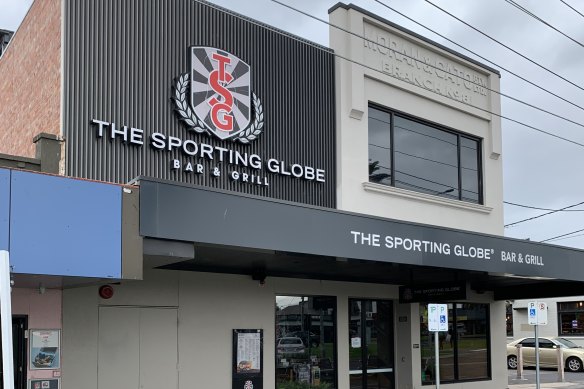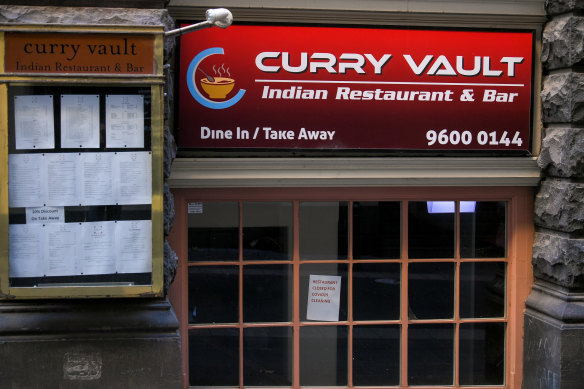This was published 3 years ago
What we know so far about Melbourne’s new coronavirus cases
By Melissa Cunningham, Benjamin Preiss and Tom Cowie
The number of cases linked to an outbreak in Melbourne’s north reached 30 on Friday, as the first case of community transmission was revealed at a bar in the city’s south-east.

Health authorities believe one of Victoria’s newest COVID-19 cases contracted the virus at the Sporting Globe in Mordialloc.Credit: Simon Schluter
It follows the reintroduction of mask wearing and restrictions on private gatherings earlier in the week after four members of the same family from the Whittlesea local government area tested positive to coronavirus.
A close contact of one of those cases also returned a positive result on Tuesday morning, before four members of his family tested positive on Tuesday afternoon.
The first five cases have been linked through genomic testing to a Melbourne man who tested positive more than two weeks ago and who is suspected of becoming infected while in hotel quarantine in South Australia.
Cases 10 to 15 include workplace contacts of case nine.

The Curry Vault restaurant in Bank Place, in the CBD, was named an exposure site after a Wollert man who contracted coronavirus dined there earlier this month.Credit: Eddie Jim
Cases 16 to 29 are either workplace or household contacts of earlier cases. Case 30 is believed to have contracted the virus at The Sporting Globe in Mordialloc.
The growing cluster has prompted a renewed plea for Victorians to get vaccinated against the virus and tested if they show even the mildest symptoms.
So, what do we know so far about each of these cases and how are they all connected?
Wollert case: patient zero
The so-called Wollert case has been dubbed patient zero in the northern suburbs cluster.
He is aged in his 30s and completed hotel quarantine in South Australia after returning to Australia from India on April 19. He tested negative to coronavirus on days one, five, nine and 13 of his 14-day stay in quarantine.
The man was discharged on May 4 and went home to Wollert, in Melbourne’s north. He developed symptoms on May 8 and tested positive to the virus two days later. The man’s three household contacts and close contacts at work were all tested and returned negative results.
Before the man tested positive he went to work for several days at the TIC group office in Altona North. He also attended a Woolworths supermarket in Melbourne’s north while infectious.
The Health Department initially wrongly listed Woolworths Epping as an exposure site. The department then acknowledged the error and confirmed it was Woolworths Epping North, about four kilometres away. It took contact tracers almost two weeks to realise the bungle.
This man also shopped at the India Gates Spices and Groceries in Epping and dined at the Curry Vault Indian Restaurant in Melbourne’s CBD. He travelled on public transport on the evening of May 7, catching the Craigieburn to Southern Cross service departing 5.28pm and arriving at 6.07pm, and the Flinders Street to Craigieburn service departing 10.20pm and arriving 11.05pm.
Strong traces of COVID-19 were picked up in wastewater in the Epping and Wollert areas last Thursday night, the first indication that the virus was spreading in the northern suburbs.
Case one: man in his 30s
Case one in the northern suburbs outbreak is a man aged in his 30s who had flu-like symptoms from May 20 and got tested on Sunday, along with a relative aged in his 70s who was asymptomatic. Both returned positive results for COVID-19 on May 24.
He lives in the Whittlesea area, in Melbourne’s outer north. Genomic sequencing has confirmed his strain of the virus is closely linked to the Wollert man’s. Both men tested positive to a highly transmissible strain of the virus that first emerged in India.
Testing also showed case one had a high viral load, meaning he was likely to be quite infectious when he was moving around the community.
Case two: man in his 70s
This man has been identified as a family member of the Whittlesea man in his 30s. He went with the younger man to get tested on Sunday and also lives in the local government area of Whittlesea, in a different household.
Case three: woman in her 70s
The woman is a family member and close contact of cases one and case two.
Case four: preschool-aged child
The child is related to cases one, two and three. The cases are spread across three different households in the City of Whittlesea. Two new locations have been listed as exposure sites for these four cases, including the Jump! Swim School in Bundoora on May 21 from 8.55am to 10.15am, and the Highpoint Shopping Centre on May 20 from 5pm to 8pm.
Case five: man in his 60s
This man has been confirmed as a close contact of the man in his 30s who was initially identified as case one in the emerging northern suburbs cluster.
Health authorities said on Friday that the man may have had mild symptoms from May 13, rather than the previously assumed May 15, meaning he could have been symptomatic in the community for 12 days before he was tested for the virus. He had a business meeting with case one on May 18, where transmission is thought to have occurred.
Chief Health Officer Brett Sutton said case five “may be the missing link” that connects the Wollert case to the cluster of four family members reported on Monday but no chains of transmission had been established.
Professor Sutton said on Tuesday morning that the man reported being symptomatic before case one – the man aged in his 30s. Health authorities are working on the theory that case five was somehow exposed to the virus through contact with the Wollert man before the northern suburbs family.
He also tested positive to a strain of the virus that first emerged in India.
However, Professor Sutton noted early investigations had not linked case five to any of the exposure sites connected to the Wollert case.
This opens the possibility there is another missing link, and that there could be more unknown cases moving silently through the community.
Cases six, seven, eight and nine
All four new cases confirmed on Tuesday afternoon are family contacts of the man in his 60s identified as case five.
Cases 10 to 15
Acting Premier James Merlino confirmed all these new infections were linked to the previous cases, saying “that’s a good thing”.
“But we are very concerned by the number and by the kind of exposure sites,” he said.
Cases 10, 11 and 12 are close primary contacts from case nine’s workplace. They all work in a finance firm in Port Melbourne.
Three hospitality venues in Port Melbourne have now been added to the exposure site list.
Case 13 is another contact of case one. Cases 14 and 15 are also workplace contacts of case nine.
Mr Merlino said contact tracers had conducted interviews throughout Tuesday night and more exposure sites were announced on Wednesday morning, with more likely to come.
Cases 16 to 26
Professor Sutton said in a media briefing on Thursday that the latest group of 11 infections were linked to previous cases. They are three men aged in their 40s, four men aged in their 30s, two men aged in their 20s and three women aged in their 20s.
“They are all linked,” he said. “There’s the workplace that’s been identified, and all of the others are the related households and casual links for the Whittlesea outbreak. That’s very reassuring.”
Cases 27 to 29
Three cases announced on Friday are linked to the Whittlesea outbreak, while another is a friend of an infected person at the finance company in Port Melbourne.
Case 30
One case announced on Friday is believed to have contracted the virus at The Sporting Globe bar in Mordialloc on May 23.
Testing chief Jeroen Weimar told reporters that the person had been at the venue for about three hours on a Sunday afternoon and evening.